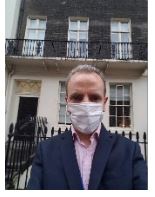Influenza is a serious illness and so we need to do all that we can to treat and prevent it. Until recently, prevention has largely evolved around vaccination. But now there is growing interest in the role that face masks can play in prevention. I have read that masks can be effective in containing respiratory virus epidemics. [1]
 But I have also read that face masks can be uncomfortable and so decided to put them to the test in a low technology, low cost simulation. I buy some face masks online and go for a walk around Warren Street. This is how I look.
But I have also read that face masks can be uncomfortable and so decided to put them to the test in a low technology, low cost simulation. I buy some face masks online and go for a walk around Warren Street. This is how I look.
How do I feel? Like a right eejit. People are staring at me and not making much of an effort to hide their stares. Do they think I am trying to avoid flu or fumes or Francisella tularensis? Wearing a mask in London is still quite unusual—I clearly stand out.
The next thing that I notice is that it is quite hard to breathe. I pull the mask away from my face to take a breath and realise that this will not help the mask to work. Is it easy to speak with the mask on? I ask an unsuspecting bystander the way to Tavistock Square—he laughs and says something in French and keeps walking. My French is terrible without a mask, so I don’t reply.
The mask is irritating and a bit claustrophobic. All in all, it is an unpleasant experience. By the time I get to the BMJ office, I want to blow my nose, rub my cheek and scratch my chin. I look at my phone when I get there and realise that I have lasted a whole seven minutes.
According to Yvonne Steinert, “by participating in a role-play, medical students or residents can discover their own feelings about a particular situation and gain insight into the patient’s presenting problems or life situation.” [2] For the investment of £8 and 8 minutes, I feel that I have learned a fair bit. More than several hours reading systematic reviews. There might be something to this idea of taking my own medicine.
Simulated role play can be expensive but there is no real reason for this always to be the case. The costs come from physical spaces, hardware and software. There are also people costs—such as those of educators, learners, and patients or actors. But all of these aren’t always necessary. The advent of fully immersive virtual reality means that quite soon many won’t be necessary at all.
In the meantime, as teachers and learners, we can exploit everything that simulation can give us. This includes unlimited practice, a healthy learning environment, safer learning and safer care, better communication and clinical skills, team-based learning, and learning that is deeply experiential.
Simulation can also happen online. How far away are we from a real time interaction with a virtual patient involving a virtual team and in a fully immersive virtual environment?
Kieran Walsh is clinical director of BMJ Learning and BMJ Best Practice. He is responsible for the editorial quality of both products. He has worked in the past as a hospital doctor—specialising in care of the elderly medicine and neurology.
Competing interests: Kieran Walsh works for BMJ which produces interactive and multimedia online learning resources on infectious and non-infectious diseases.
References:
- Jefferson T, Del Mar CB, Dooley L, Ferroni E, Al-Ansary LA, Bawazeer GA, van Driel ML, Nair S, Jones MA, Thorning S, Conly JM. Physical interventions to interrupt or reduce the spread of respiratory viruses. Cochrane Database Syst Rev. 2011 Jul 6;(7):CD006207.
- Steinert Y. Twelve tips for using role-plays in clinical teaching. Med Teach Jan 1993, Vol. 15, No. 4: 283–291.
